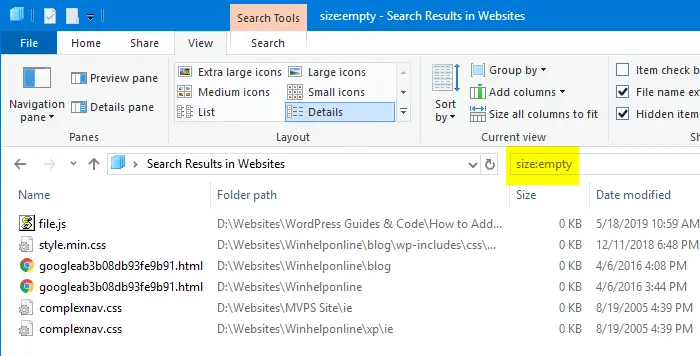
- Non empty file when copied is zero byte file portable#
- Non empty file when copied is zero byte file windows#
Originally designed as an 8-bit file system, the maximum number of clusters has been significantly increased as disk drives have evolved, and so the number of bits used to identify each cluster has grown.

In much the same way, sub-directories are implemented as special files containing the directory entries of their respective files. The root directory of the disk contains the number of the first cluster of each file in that directory the operating system can then traverse the FAT table, looking up the cluster number of each successive part of the disk file as a cluster chain until the end of the file is reached. Each entry contains either the number of the next cluster in the file, or else a marker indicating end of file, unused disk space, or special reserved areas of the disk. The table contains entries for each cluster, a contiguous area of disk storage. The name of the file system originates from the file system's prominent usage of an index table, the File Allocation Table, statically allocated at the time of formatting. 3.1.3 FAT32 Extended BIOS Parameter Block.According to Google Patents the status of "Common name space for long and short filenames" (US5758352A) was expired in 2019, which may mean that the patent has expired completely. These standards cover FAT12 and FAT16 with only short 8.3 filename support long filenames with VFAT are partially patented. FAT is also utilized for the EFI system partition (partition type 0圎F) in the boot stage of EFI-compliant computers.įor floppy disks, FAT has been standardized as ECMA-107 and ISO/ IEC 9293:1994 (superseding ISO 9293:1987 ). DCF implements FAT as the standard file system for digital cameras since 1998.
Non empty file when copied is zero byte file portable#
Today, FAT file systems are still commonly found on floppy disks, USB sticks, flash and other solid-state memory cards and modules, and many portable and embedded devices.
Non empty file when copied is zero byte file windows#
Originally designed in 1977 for use on floppy disks, FAT was soon adapted and used almost universally on hard disks throughout the DOS and Windows 9x eras for two decades. It is, however, supported for compatibility reasons by nearly all currently developed operating systems for personal computers and many home computers, mobile devices and embedded systems, and thus is a well suited format for data exchange between computers and devices of almost any type and age from 1981 through the present. It offers good performance even in very light-weight implementations, but cannot deliver the same performance, reliability and scalability as some modern file systems. The FAT file system is a legacy file system which is simple and robust. Read-only, Hidden, System, Volume, Directory, ArchiveįAT12/FAT16: File, directory and volume access rights for Read, Write, Execute, Delete only with DR-DOS, PalmDOS, Novell DOS, OpenDOS, FlexOS, 4680 OS, 4690 OS, Concurrent DOS, Multiuser DOS, System Manager, REAL/32 (Execute right only with FlexOS, 4680 OS, 4690 OS individual file / directory passwords not with FlexOS, 4680 OS, 4690 OS World/ Group/ Owner permission classes only with multiuser security loaded)įAT32: Partial, only with DR-DOS, REAL/ OSįAT12/FAT16: Per-volume, SuperStor, Stacker, DoubleSpace, DriveSpaceĪ FAT file system is a specific type of computer file system architecture and a family of industry-standard file systems utilizing it. Modified date/time, creation date/time (DOS 7.0 and higher only), access date (only available with ACCDATE enabled), deletion date/time (only with DELWATCH 2)

Microsoft, SCP, IBM, Compaq, Digital Research, Novell, CalderaįAT32 (32-bit version with 28 bits used),įAT16B: November 1987 ( Compaq MS-DOS 3.31)ĮxFAT: November 2006 ( Windows Embedded CE 6.0)Ĥ,294,967,295 bytes (4 GB - 1) with FAT16B and FAT32 Ĩ.3 filename, or 255 UCS-2 characters when using LFN For a more accessible and less technical introduction to this topic, see File Allocation Table.


 0 kommentar(er)
0 kommentar(er)
